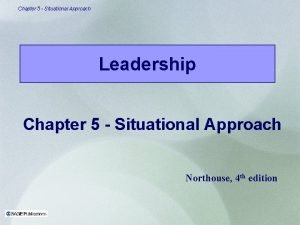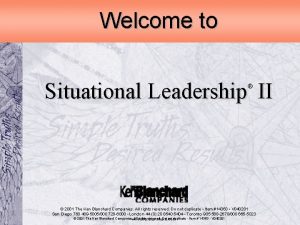Types of Leadership Situational Situational Approach As the











- Slides: 11

Types of Leadership Situational

Situational Approach • “As the name of the approach implies, the situational approach focuses on leadership in situations. The premise of theory is that different situations demand different kinds of leadership. From this perspective, to be an effective leader requires that a person adapt his or her style to the demands of different situations. ” (Northouse, 93)

Effective Leaders “Effective leaders are those who can recognize what followers need and then adapt their own style to meet those needs. ” (Northouse, 93) “Leadership style consists of the behavior pattern of a person who attempts to influence others. ” (Northouse, 94)

Directive and Supportive Situational Leadership needs both Directive – Giving Directions, Strength & Supportive – Acceptance, Friendliness, Understanding These dimensions need to be applied appropriately to given situations.

Directive Characteristics - Directive behaviors help group members accomplish goals by giving directions, - establishing goals - methods of evaluation - setting timelines - defining roles - showing how the goals are to be achieved. Drawbacks - One-way communication: - what is to be done - how it is to be done - who is responsible for doing it (Northouse, 94)

Supportive • help group members feel comfortable • involve two-way communication • responses show social and emotional support to others. • asking for input • solving problems • praising, • sharing information about oneself • Listening (Northouse, 94)

4 Categories 1. High directive – low supportive (directing) leader focuses communication on goal achievement 2. High directive – high supportive (coaching) communication on both achieving goals and meeting followers’ socioemotional needs

4 Categories Continued 3. High supportive – low directive (supporting) uses supportive behaviors that bring out followers’ skills around the goal to be accomplished. 4. Low supportive – low directive (delegating) leader offers less goal input and social support, facilitating followers’ confidence and motivation in reference to the goal

Diagram

Diagram Explanation In your groups analyze and explain the diagram.

Case Studies • Once you feel like you understand the diagram, go to our website and complete the case studies on situational leadership posted there.
 Adaptive leadership theory
Adaptive leadership theory Adaptive leadership vs situational leadership
Adaptive leadership vs situational leadership Situational approach
Situational approach The ken blanchard companies situational leadership ii
The ken blanchard companies situational leadership ii Situational theory of leadership emphasize
Situational theory of leadership emphasize Situational leadership theory emphasizes
Situational leadership theory emphasizes Situational leadership grid
Situational leadership grid Situational leadership questionnaire
Situational leadership questionnaire Situational leadership
Situational leadership Situational leadership videos
Situational leadership videos Colin powell situational leadership
Colin powell situational leadership Hse culture ladder
Hse culture ladder

















